The Hong Kong Monetary Authority (HKMA) released today the findings of a comprehensive survey on residential mortgages in Hong Kong (September 1997).
The findings suggest that residential mortgage loans in Hong Kong are of high quality. As at end-September 1997 :
- average outstanding principal was relatively low at $1.3 mn, suggesting banks are targetting at the relatively less volatile mass market;
- average LTV ratio at a prudent level of 52%, providing a sizeable cushion to absorb correction in property prices;
- the majority of mortgage flats (93%) were owner occupied. Property for investment purpose which are generally more risky account for only 7%; and
- very low delinquency ratio, at 0.1% (loan delinquency is defined here as loans overdue for more than 90 days).
Commenting on the survey findings, a spokesman for the HKMA said, "While there has been a correction in property prices since October 1997, banks still have a considerable cushion for their mortgage assets as a whole. The findings also show that during the property market downturn in the second half of 1994 and 1995, the loan delinquency ratio remained low, at around 0.2% in 1995 and 1996. Besides, in all default cases, the loan amounts were reported to be fully recovered."
The survey covered 39 authorized institutions active in residential mortgage lending. Together they accounted for approximately 95% of the total outstanding mortgage loans extended by authorized institutions in Hong Kong. The survey collected information on the characteristics and performance of the residential mortgage loans as well as the lending policy of the authorized institutions. In view of the strong demand for up-to-date statistics on residential mortgages, the HKMA is reviewing the need to collect those statistics on a more frequent basis.
A report on the findings of the September 1997 Survey is attached.
Hong Kong Monetary Authority
25 February 1998
EXECUTIVE SUMMARY
With a view to obtaining updated information on the characteristics and performance of residential mortgage loans in Hong Kong, the Hong Kong Monetary Authority (HKMA) has recently conducted a comprehensive survey on the residential mortgage market, similar to the one carried out in September 1994.
2. A total of 39 authorised institutions, which account for approximately 95% of total outstanding mortgage loans extended by all authorized institutions in Hong Kong, participated in the survey 1 .
3. A comparison of the 1994 and 1997 survey findings are presented in Table 1 below :

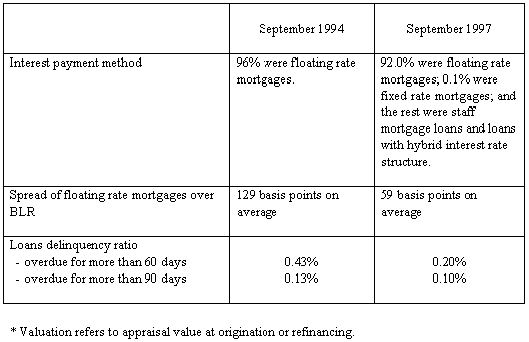
4. The salient findings of the 1997 Survey are highlighted as follows:
- the ratio of outstanding loans to property value (assessed at loan origination or refinancing) averaged 52.0% 2 as at end-September 1997, lower than the ratio of 53.3% at end-September 1994 and substantially below the maximum LTV ratio (at origination) of 70%;
- the mortgage loans were on average seasoned for 19 months. During this period (February 1996 to September 1997), the property price index compiled by the Rating and Valuation Department rose by over 50%, suggesting that the current LTV (i.e. the ratio of outstanding loans to current property value) should be considerately lower on average;
- reflecting the high quality of mortgage loans in Hong Kong, the loan delinquency ratio (measured by the ratio of mortgage loans overdue for more than 90 days to total outstanding mortgage loans) was only 0.10% as at end-September 1997, lower than the corresponding ratio of 0.13% as at end-September 1994; and
- in part reflecting keen competition for mortgage business in the first three quarters of 1997, the average spread of the mortgage rate over BLR narrowed to 59 basis points as at end-September 1997, compared with 129 basis points as at end-September 1994.
5. Section I of the Report presents the findings on the characteristics of the residential mortgage loans. Section II describes the performance of the loans and Section III highlights the lending policies of the authorised institutions.
1 Of these 39 authorised institutions, 16 were only able to provide the statistics based on samples in certain parts of the survey.
2 As the mortgage loans were on average seasoned for only 19 months, the ratio of original loan amount to property value at loan origination or refinancing should be fairly close to 52.0%.
COVERAGE OF THE SURVEY
The survey covers Hong Kong dollar denominated mortgage loans for residential properties in Hong Kong, other than those for flats in the Home Ownership Scheme and the Private Sector Participation Scheme.
Section I - Characteristics of Residential Mortgage Loans
Overview
2. As at end-September 1997, a total of 383,370 outstanding residential mortgage loans 3 , involving an amount of HK$493 bn, were reported by the 39 authorised institutions (AIs) participating in the survey 4 .
Outstanding Mortgage Loan Size
3. As at end-September 1997, the average outstanding amount per loan was HK$1.3 mn, an increase of 62.5% over the corresponding figure of HK$0.8 mn as at end-September 1994. The increase in loan amount was largely attributable to a rise in property prices.
Outstanding Loan-to-Valuation Ratio
4. The average ratio of outstanding loan to property value (assessed at the time of loan origination or refinancing) was 52.0% as at end September 1997 5 , lower than the ratio of 53.3% as at end-September 1994 and considerably below the maximum LTV ratio at origination of 70%. Apparently some borrowers ploughed back part of their capital gains as they traded up the property market.
Life of Properties and of Mortgage Loans
5. 56.4% of the total outstanding loans were mortgaged on residential properties aged below 10 years as at end-September 1997. Those between 10 and 20 years old accounted for 28.0%, while properties over 20 years old accounted for only 7.7%.
6. In terms of the contractual life of the mortgage loans, the average was about 221 months (or 18.4 years). They were on average seasoned for about 19 months (or 1.6 years), with a remaining contractual life of 202 months (or 16.8 years). By comparison, the mortgage loans as at end-September 1994 were on average seasoned for 23 months. The shortening of the seasoning period was due to a substantial increase in new loans during the early part of 1997.
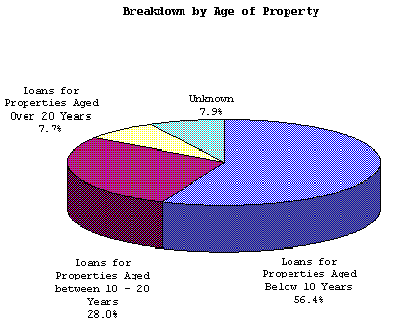
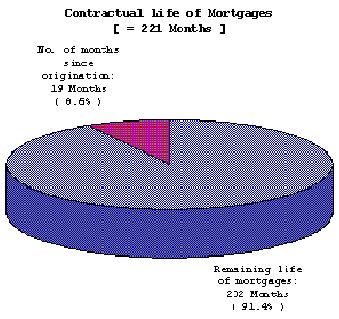
Occupancy Status and Loan Purpose
7. An overwhelming proportion (92.9%) of mortgage loans were reported to be owner-occupied. Others were loans involving non-owner occupied properties, probably for investment purposes. Broken down by loan purpose, 91.7% of total outstanding loans were for financing the purchase of flats. Refinancing loans accounted for 8.3%.
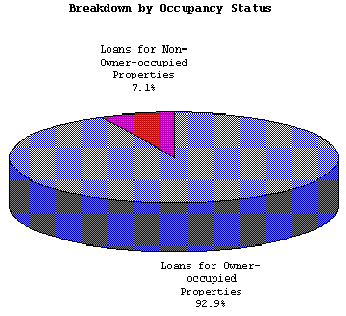
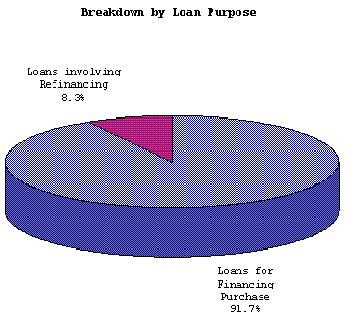
Interest Payment Method
8. Loans on floating rate terms continued to account for an overwhelming proportion of the outstanding mortgage market. As at end September 1997, 92.0% of the outstanding mortgage loans were arranged on floating rate basis and fixed rate loans accounted for under 0.1% of the total. Staff mortgage loans and loans of a hybrid nature 6 accounted for 7.9% of the total outstanding loans.
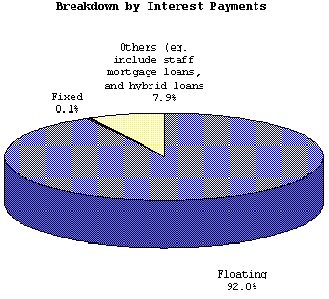
9. With respect to floating rate loans, around 70.9% involved a repayment scheme under which interest rate adjustment was made to the monthly instalment amount. Around 29.1% involved a repayment scheme under which adjustments to mortgage rates were made to the repayment period, leaving the mortgage instalment amount unchanged.
10. Virtually all (99.9%) of the floating rate mortgages were based on the Best Lending Rate (BLR). The remaining (0.1%) were set with reference to HIBOR or deposit rates. The average spread of the mortgage rate over the BLR narrowed substantially from 129 basis points as at end-September 1994 to 59 basis points as at end-September 1997, partly reflecting the keen competition among banks for mortgage business in the early part of 1997.
Scheduled Payment and Prepayment
11. In the first nine months of 1997, scheduled contractual principal payment of mortgage loans was about 4.4% of total outstanding loans. The amount of partial prepayment and complete prepayment were equivalent to 2.7% and 21.4% of total outstanding loans respectively. The latter was 11.1 percentage points higher than the corresponding figure of 10.3% in 1994, partly reflecting the active trading in the property market in the early part of 1997.
3 The total stock of private domestic units (excluding those in the Home Ownership Scheme and the Private Sector Participation Scheme) was 911,240 as at end 1996 in Hong Kong. The survey findings suggested that roughly 42% of these units had outstanding mortgages. A similar ratio (40%) was recorded in the survey conducted in 1994 (Source: Hong Kong Property Review 1997, Rating and Valuation Department).
4 As at end September 1997, the outstanding amount of loans to professionals and private individuals to finance the purchase of private residential properties stood at HK$473 bn (Source: HKMA Monthly Statistical Bulletin, January 1998). The larger figure recorded in the survey was due to the broader coverage of the survey, which included also residential mortgage loans extended to corporate borrowers. Besides, a few submissions were based on records as at end-November 1997.
5 Unless otherwise specified, ratios and average values quoted in this report are weighted by the outstanding amount of mortgage loans. This has the effect of assigning a higher weight to more recent mortgages which involved a larger amount relative to older mortgages.
6 These refer to loans which are not of straightly floating or fixed rate nature, examples include loans which are fixed for the first 2 years at a certain rate and than floating in accordance to an index until maturity.
Section II - Performance of Mortgage Loans
12. Table 2 shows the loan delinquency ratio during the period from September 1994 to September 1997. As at end-September 1997, the loan delinquency ratio, measured in terms of loans overdue for more than 90 days as a percentage of total outstanding loans, stood at 0.10%, lower than the corresponding figure of 0.13% as at end September 1994. Notwithstanding the correction in residential properties in the second half of 1994 and 1995, the loan delinquency ratio remained low in these two years, at around 0.20%.
13. The delinquent loans reported as at end-September 1997 were on average seasoned for 22 months. The average loan-to-valuation ratio of these loans were 62.8%, 10.8 percentage points higher than the market average of 52.0%. Mortgagee actions (in the form of repossession of the property) generally took place about 11 months after the loans were overdue for one month. In all default cases, the loan amount was fully recovered.
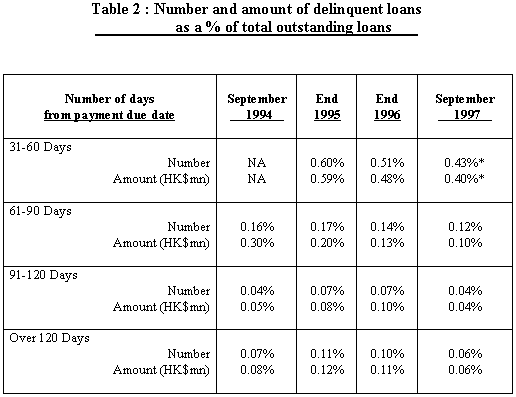
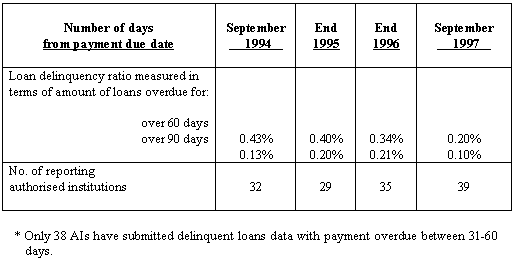
Section III - Lending Policy of Authorized Institutions since 1994
14. Table 3 below summarizes the lending policy of the reporting institutions.
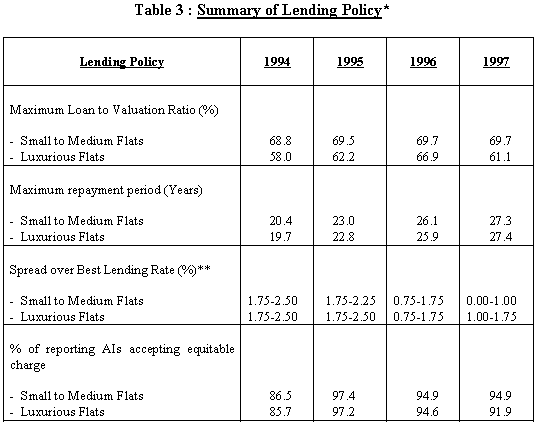
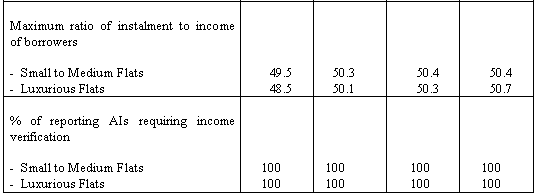
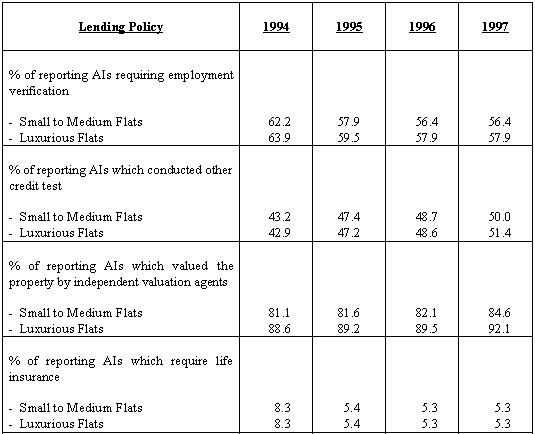
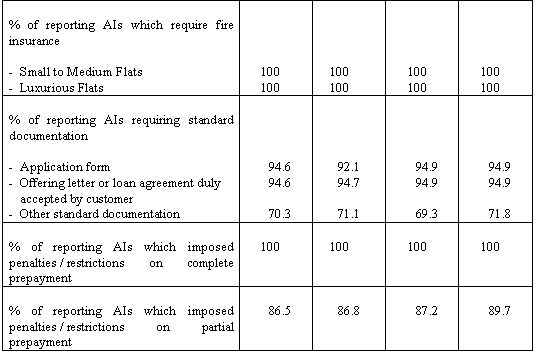
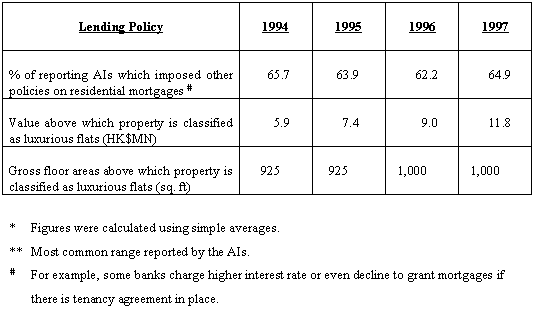
Maximum loan-to-valuation ratio and maximum repayment period
15. The maximum loan-to-valuation ratio remained close to 70% for small to medium flats and 60% for luxurious flats in the past few years. But the maximum repayment period has lengthened to around 27 years. A number of authorised institutions have been more flexible in terms of the property age, and used the sum of property age and the contractual maturity of the mortgage loans as a cap, which were generally set at 40 years.
Maximum ratio of instalment to income of borrowers
16. With the exception of a few authorised institutions which allowed a 55% ratio, most authorised institutions adopted a 50% limit. Some authorised institutions have slightly different limits for small and medium flats and luxurious flats.
Classification of luxurious flats
17. The dividing line for luxurious property in value terms rose from an average of HK$6 million in 1994 to around HK$12 million in 1997, reflecting the increase in property prices. In terms of gross floor area, the dividing line remained close to 1,000 square feet.
Prepayment Penalty
18. All authorised institutions participating in the survey enforced some form of penalty on complete prepayment, mostly in the first year since the origination of the loans. Penalty on partial prepayment seemed to have become more prevalent.















